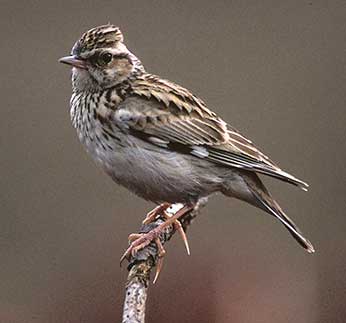Woodlark (Lullula arborea)
When: All year round, although not often recorded in December and January
How many: Moderate numbers

Woodlarks occur widely in the New Forest. In fact, they are something of a New Forest speciality. Woodlark breeding distribution is largely centred on the New Forest and a number of other traditional areas - the Hampshire/Surrey heaths, parts of Sussex and Devon, the East Anglian Brecks and parts of coastal Suffolk.
Here, woodlark sightings are possible in all months of the year, but in winter, many birds leave the area, some to travel down into mainland Europe. Outside the breeding season, it is, though, difficult to accurately assess woodlark numbers present, as these are inconspicuous creatures that for much of the time remain on the ground, hidden amongst the vegetation.
When disturbed – and that often means when almost trodden upon by a New Forest pony or human intruder – woodlarks reluctantly take to the air, often calling softly, and often only then revealing the presence of an otherwise unsuspected, well-spread group.
Yes, woodlarks are certainly inconspicuous and secretive, until, that is, they get the urge to sing. Then, often from way on high, but sometimes from a perch, a repeated series of hauntingly beautiful, mellow, fluting notes shower down to earth.
Heard from late-January or February, song has been most appropriately described as sweet, but with a hint of melancholy. ‘Lu-lu-lu’ notes are a particular feature, contributing to the bird’s scientific name Lullula. Indeed, in France it is known as Lulu.
The arborea element of the scientific name and the reference to wood in the common name, is, however, somewhat misleading, for in the New Forest, the woodlark’s favoured home is heathland, although areas of regenerating clear-fell will sometimes be used.
(In Germany, they are more appropriately known as Heidelerche, or heath lark).
Until a really good view is obtained, woodlarks appear to be nondescript little creatures with few distinguishing characteristics, ideally suited to a quiet life amongst the heather. But on closer examination, the beauty of the woodlark's cryptically patterned browns, cream and darker coloured plumage becomes clear, and so do the prominent, pale eye stripes that go right the way back to join at the nape.
Then once airborne, short, broad, rounded wings, and equally short, square stubby tail are immediately noticeable.
Woodlark nests are built on the ground, often amongst relatively newly burnt heather stems or short, rough grass. The flimsy cup of delicate, woven stems and leaves, lined with finer grasses and hair is usually quite flattened by the time the young have fledged.
Three to five eggs are normally laid, incubation lasts from 12-15 days, and the young woodlarks fledge after a further 10-13 days. When in the nest, youngsters are as equally well camouflaged as the adults, which is just as well, as foxes and marauding crows are ever on the lookout for an easy meal.
Numbers currently are relatively high – a 1986 census revealed 55 territories in the New Forest, which by 1997 had increased to 183. By 2006, numbers had slightly fallen back, but still showed an estimated 160 territories.
Indeed, nowadays, in parts of the New Forest, woodlarks may be more frequently encountered than closely related skylarks.
References:
The Shell Guide to the Birds of Britain and Ireland: James Ferguson-Lees, Ian Willis and J.T.R. Sharrock
Hampshire Bird Reports: Hampshire Ornithological Society
The Birds of the Western Palearctic, Concise Edition: D.W. Snow and C.M. Perrins
The New Atlas of Breeding Birds in Britain and Ireland (1988-91): D.W. Gibbons, J.B. Reid and R.A. Chapman
More links
Other related links
Search this site

Sadly, 58 animals were killed - 35 ponies, 13 cows, 8 donkeys and 2 sheep, whilst a further 32 were injured - 3 pigs, 9 donkeys, 11 cows and 9 ponies.
(Forty-three accidents occurred in daylight, 15 at twilight and 101 in the dark. Twenty-seven accidents were not reported by the driver involved).
Here's just one horrific example - Three donkeys killed in collision with van at notorious New Forest blackspot (Advertiser and Times)

